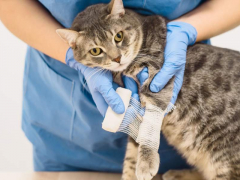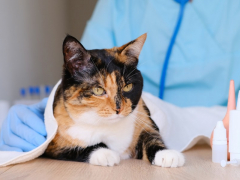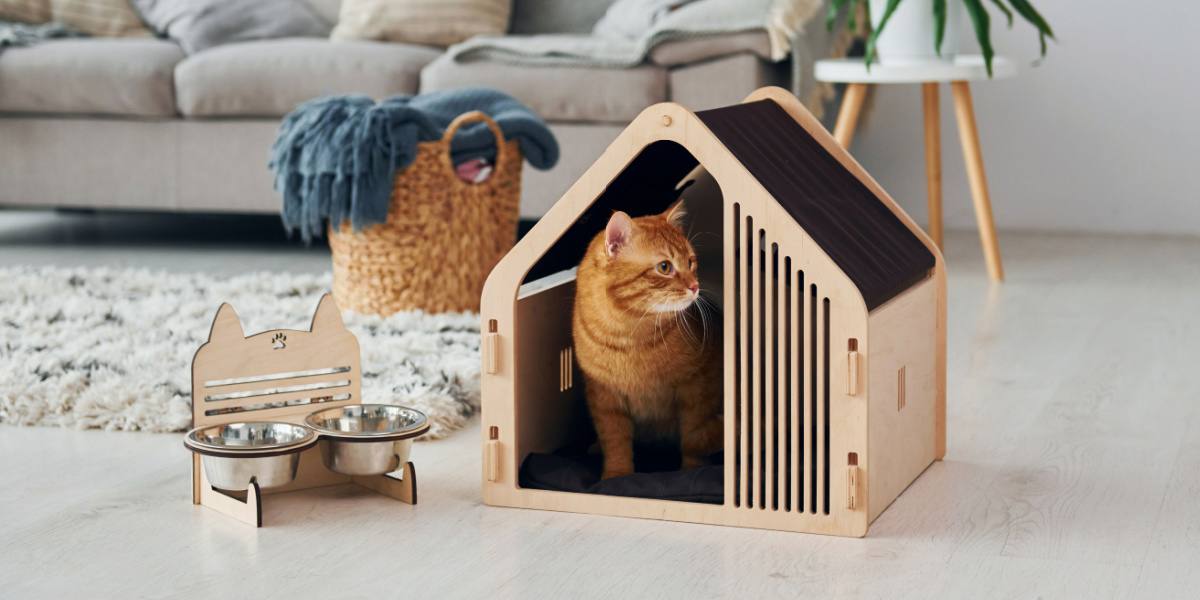
Getting a new cat is a joyful time, and every cat owner wants their new family member to settle in well. A new environment can be stressful for cats, especially because they are territorial. Never fear! There are plenty of ways to make the process as cat-friendly as possible, by providing key resources, offering some TLC, and letting your new pet settle into their forever cat home in their own time.
As a veterinarian, lifetime cat lover, and owner, here are my top tips to help your cat feel safe and secure in their new surroundings.
1. Provide a Safe Space
When your cat first arrives in their new house, they will be faced with many challenges: a new territory, unfamiliar people, and perhaps even other cats and dogs. In order to reduce the amount of overwhelm, start your cat off in a safe room where they can spend their first few days.
Provide them with key resources, such as food, water, a litter box, a cat bed, and some toys, and give them time to relax in their new environment. Your new cat might be feeling stressed after a trip in the cat carrier to this new, unfamiliar place, so some hiding places are always recommended.
2. Book a Checkup at the Veterinary Clinic
This needn’t happen on the first day, but a veterinary exam is recommended for all new pets. The veterinarian can give your new cat an examination, discuss routine health care such as vaccinations and parasite prevention, and discuss any concerns about cat behavior or medical care. Also, always remember to check that your new cat’s microchip information has been updated.
3. Cat-Proof Your House
After the first few days, you’ll likely want to let your cat out into the rest of the house. They will naturally want to thoroughly explore their new home, so making sure it is fully cat-safe is essential.
Cats are very good at jumping up high, so countertops are not the safe place for things like food and medications that you might think. Take a walk around your house, watching out for fragile objects, small gaps, electrical wires, and unsecured furniture.
4. Think About the Litter Tray
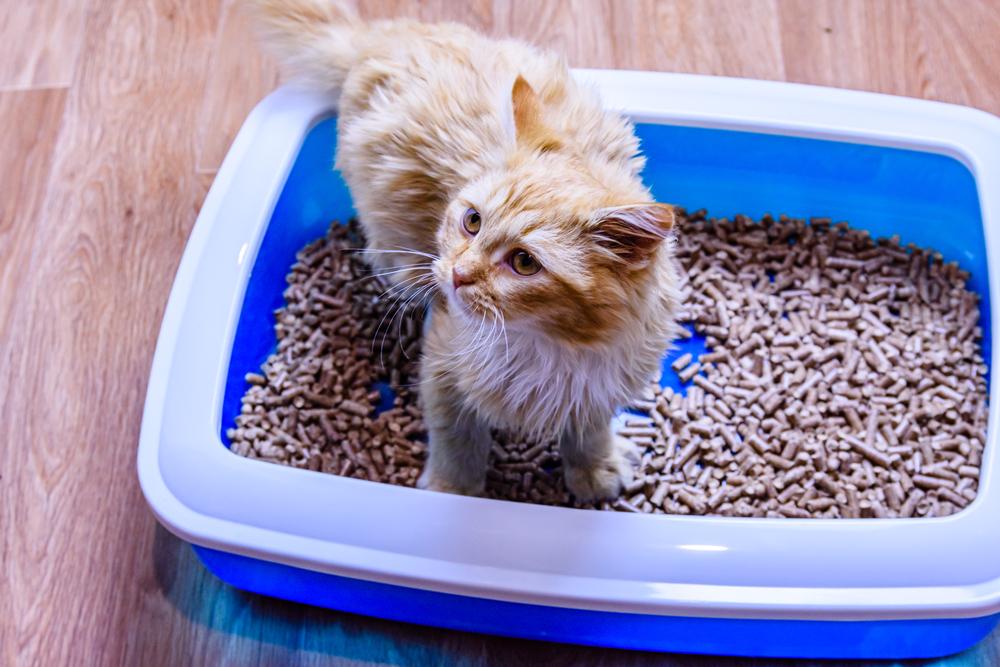
If you know what type of litter your new cat was using before, start with that at home.
Setting up a litter box might seem pretty straightforward: buy a box, buy some litter, then put it somewhere, right? However, putting a bit more consideration into this essential resource may help your cat’s transition. Cats tend to form strong preferences for what substrate they use, so try to get the same litter your new cat has been used to. Otherwise, go for a fine, sandy litter which is what most cats prefer.
Likewise, some cats prefer a covered litter box, and some an open tray, so giving them a choice is recommended. You should always have more litter boxes than cats, so buy a couple!
5. Position the Resources
Cats are territorial, and they also like to have certain key resources in certain places. Having things like the water bowls too close to the food bowl, or the litter box near the cat’s food can cause significant stress to our fastidious felines.
Place the litter box away from food and water, and preferably someone quiet—most cats prefer to poop in private. The food and water bowl can be in busier areas but should be separated from each other. Place bowls a little away from walls so that cats don’t have to turn their back on their surroundings to eat or drink.
6. Food
Cats require a diet that is nutritionally complete and balanced correctly for their age and lifestyle. Kittens have different dietary requirements from adult cats, and seniors vary again. Try to make any dietary transition slowly over the course of a week to avoid tummy upset. It’s recommended to feed them whatever diet they were previously on for the first few days in a new home until they’ve settled in, at which time you can transition to a new food if you prefer.
7. Bed and Hiding Places
With total sleep time totaling up to around 18 hours daily, cats certainly are experts at snoozing. Provide a comfy bed or two—preferably somewhere off the floor, as cats like to have a good vantage point. Nervous cats, especially those who are just getting used to their new space, will also appreciate a few hiding places. These don’t have to be fancy or expensive—cardboard boxes are often a favorite!
8. Scratching Opportunities
Cats have a strong innate need to scratch. Not only does scratching sharpen their claws, but it is also a form of communication, as these territorial creatures release scent chemicals from their paws as they scratch. Provide several scratching posts to help prevent damage to your floors, curtains, and furniture!
9. Climbing
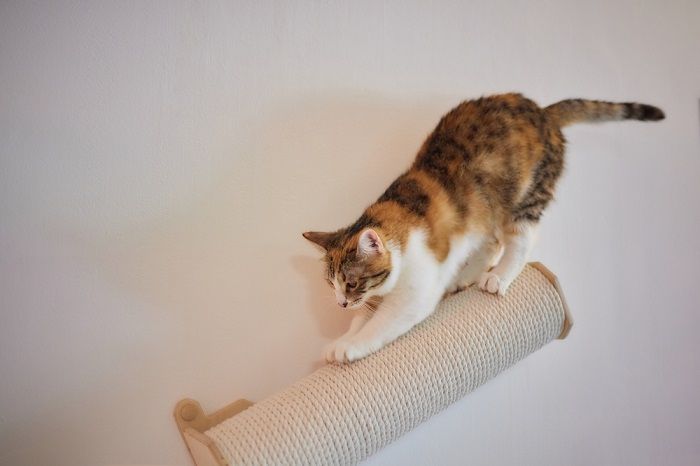
Low-profile cat climbing ramps and shelves allow you to take advantage of the vertical space in your home.
Similarly to scratching, cats are highly motivated to climb. If there are no alternatives, you might find them scaling the drapes, or perched on top of a bookcase. Cat trees can encourage safe climbing and active play, perfect both for mental stimulation and physical exercise.
10. Enrichment and Toys
Cats are active, playful animals. Boredom, frustration, and lack of exercise can lead to negative behaviors such as aggression, destructive behavior, and inappropriate toileting. Cat toys, puzzle games, and encouraging active play are all really beneficial for cats, and can help you bond with them, too.
11. Pheromones
Cats use chemical messages (pheromones) to communicate with both themselves and with other cats. When a cat rubs its face against you or an object such as a favorite bed, they are marking it as familiar, safe, and comforting. Synthetic pheromones, such as Feliway, can help reduce stress by projecting reassuring scent messages to your cat.
These can be particularly needed when a cat moves into a new home, where nothing smells familiar or safe. Feliway can work via plug-in diffusers, or as a spray, and can be used in the home, the cat carrier, or even the car.
12. Spend Time Bonding
Moving to a new home can be a scary and overwhelming time for a cat. Forming a strong bond with their new owner can be a reassuring and comforting social link. Spend time with your new pet, so that your presence, smell and sounds become familiar to them.
Some cats might hide away, in which case merely sitting near them and perhaps tempting them with a tasty treat or two is a good way to start. Once more confident, active bonding such as grooming, playing, and petting are all good ways to form a strong relationship. Read about forming a strong bond here.
13. Introductions To Other Pets
Bringing a new cat into the household is a time of change for you, but also for any other pets, you might have. To start, keep your new cat separate from other pets, and allow them time and space to settle into their new environment.
When ready, take introductions very slowly and calmly for the best possible chance to end up with a peaceful and social household. Need some help? Check out introducing a kitten to a cat and introducing cats and dogs.
14. Watch for Signs of Stress
Moving into a new home can be a stressful and overwhelming experience for your cat. Keep a close eye for any signs of stress, such as toileting outside the litter box, excessive meowing, hiding away more, and changes to appetite and aggression. Early intervention can help you achieve a swift resolution. Always speak to a veterinarian if you are concerned about your cat’s health or behavior.
15. Enjoy Your New Pet!

Enjoy the cuddles and purrs with your new pet—it’s only the beginning!
Bringing a new cat home is an exciting experience! Remember the rule of three: The first three days your new cat might be overwhelmed and a bit anxious. By three weeks they should be settling in well. By three months most cats are very happy in their home environment.
Follow all our tips for a smoother, calmer adjustment for both you and your pet, and try to make time to just enjoy each other. There’s nothing better than that first snuggle with a new fluffy family member.
Also Read: 10 Signs Your Cat Really Does Trust You
